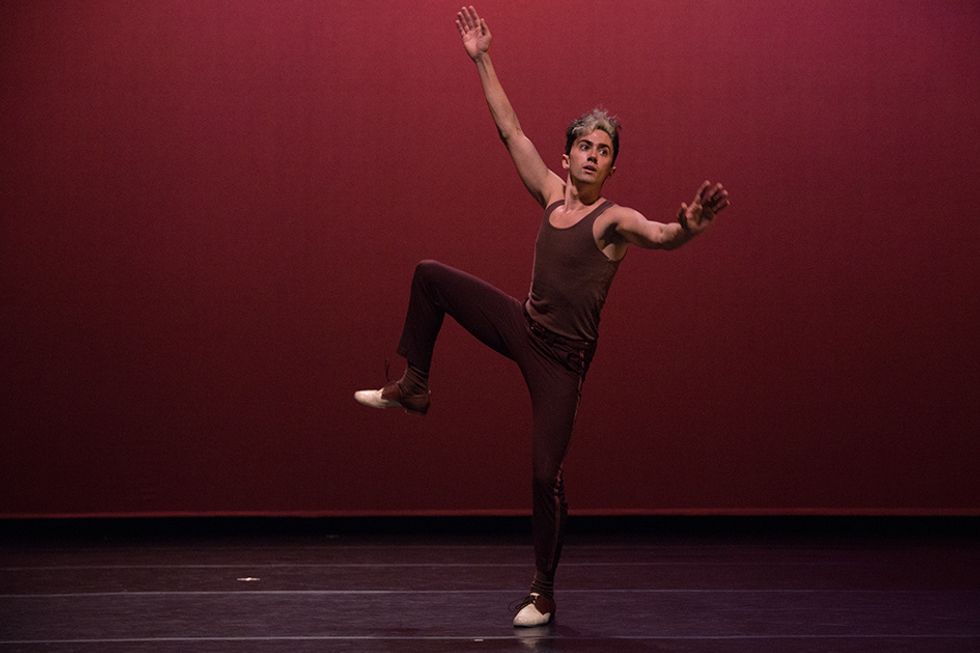Caleb Teicher's First Evening-Length Takes Place in a Sandbox
With a style that fuses tap dance, Lindy hop and vernacular jazz, Caleb Teicher has quickly proven himself a choreographic force to be reckoned with. After becoming known as a Bessie Award–winning member of Michelle Dorrance’s company (and a DM “25 to Watch” pick in 2012), Teicher started his own troupe in 2015. Since then, he’s presented at high-profile venues like The Joyce and Jacob’s Pillow’s Inside/Out stage, and last year he was commissioned by New York City Center’s popular Fall for Dance festival. This month, Caleb Teicher & Company will premiere its first evening-length work, More Forever, commissioned by Works & Process at the Guggenheim.
Tell us about More Forever.
We’ve built a custom sandbox which is 24 feet by 24 feet, and over the course of the piece we accumulate a thin layer of sand on the floor—so the sound we’re making is a leather-soled shoe meeting a wood floor, with sand in between. In a very poetic sense, the piece is about the passage of time and the relationships we make with other people, the sadness and beauty of watching people come and go in our lives.
What got you interested in sand?
I was excited by the idea of putting a group of people onstage with sand in a space where you can really move around. Most sand dancing is done on a very small platform, and it’s one person dancing at a time. There are so many interesting visual and musical possibilities with sand. When you drag your foot along the floor, you can have a sustained sound, and it just opens up a whole new world. Tap is a form where you mean to make a particular sound, and in Lindy hop and vernacular jazz, sound is sort of a byproduct—stomping and clapping and footfalls. We’re using all those forms so that we have a really rich palette to hear and see.
 Caleb Teicher. Photo by Em Watson, Courtesy Michelle Tabnick Public Relations
Caleb Teicher. Photo by Em Watson, Courtesy Michelle Tabnick Public Relations
How was collaborating with pianist and composer Conrad Tao?
We met through the National YoungArts Foundation—we were both finalists in 2011. I found him to be supremely talented from a technical perspective, but also so expressive. Conrad says this is his first time writing music with dance, because the dancing we’re doing makes sounds. Conrad is playing piano, but he’s also using some electronics and some toy piano.
Toy piano?
Toy piano—like a Peanuts cartoon. It has a beautiful, music box kind of sound. We were trying to figure out how to get him into the sandbox with us, because he really feels like part of the group—he’s not just accompanying. The easiest way to do that was to find an instrument that he could play without sitting at the grand piano. Part of how we’ve staged the work is to relate to Conrad as a physical presence, not just a musical one. There’s also a moment in the show where he plays a grand piano and a toy piano simultaneously.
 Caleb Teicher & Company performing at Fall for Dance. Photo by Em Watson, Courtesy Michelle Tabnick Public Relations
Caleb Teicher & Company performing at Fall for Dance. Photo by Em Watson, Courtesy Michelle Tabnick Public Relations
What are some of the other challenges that came up?
This company is still small and young and new, so everything feels huge. I’ve said recently that putting on a live performance is like planning a wedding. Our ideas are ambitious and adventurous, and kind of logistically complicated, but we’re pushing through to get to this thing that we are so excited about and we really love. The work is totally worth it.




